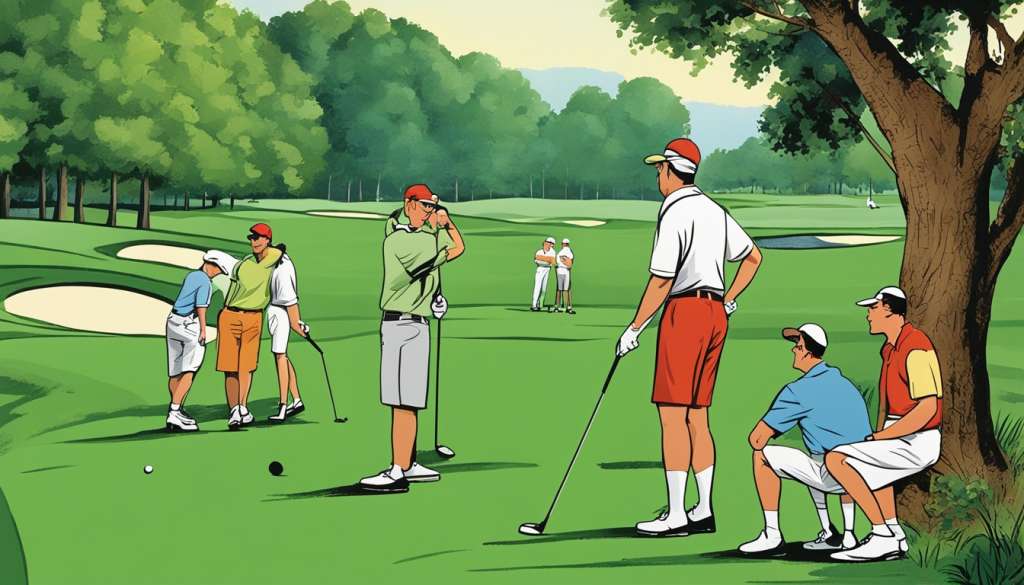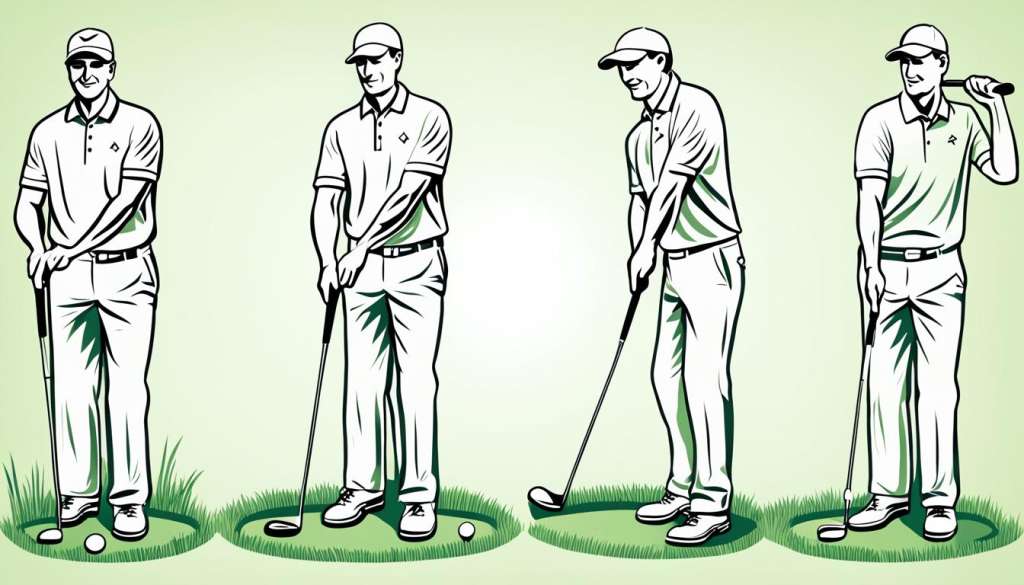Get ready to explore the world of golf etiquette. This guide will walk you through the unwritten rules and manners that make golf special. By learning and following these rules, you’ll make your golfing experience better and show respect to others and the game.
Golf is more than hitting a ball into a hole. It’s a game filled with tradition, sportsmanship, and integrity. The USGA sets the rules, starting with Rule 1, which tells you to play the course as you find it and be your own referee. This honesty and self-control make golf unique.
In this guide, you’ll learn the basics of golf etiquette, like what to wear and how to play at a good pace. You’ll see how to take care of the course and interact with other players. By getting these manners right, you’ll not only get better at golf but also earn respect from others.
Understanding the Importance of Golf Etiquette
Golf etiquette is key to the sport, making the game fun for all players. It’s about following the rules that aren’t written down. By knowing these rules, you help make the game better for everyone.
The Spirit of the Game
Golf relies on players being honest. You should call penalties on yourself, even if no one else sees it. This honesty builds trust and keeps the game’s traditions alive.
Respect for Fellow Players
Being considerate towards others is vital in golf. Keep up a good pace to not slow down others. Be quiet when others are hitting, and watch where your shadow falls on the green. These actions greatly improve the game for everyone.
Care for the Course
Looking after the golf course is everyone’s job. Fix your divots, repair ball marks, and rake bunkers. This keeps the course in good shape for you and others. Remember, playing at a good pace also means taking care of the course.
- Replace divots in the fairway
- Repair ball marks on the green
- Rake bunkers after use
- Keep carts on designated paths
Following these rules makes your game better and helps everyone else too. Golf etiquette is about respect, honesty, and care. These values matter a lot, even off the course.
Arriving at the Course: Preparation and Punctuality
Arriving at the golf course ready and on time is key for a great round. Golf course rules stress the importance of being punctual. Plan to arrive at least 30 minutes before your tee time. This gives you time to settle in and get ready.
Begin your warm-up with short irons and move to woods gradually. End with some soft wedge shots to sharpen your touch. Then, head to the practice green for putting to feel the day’s green speeds.
Take a moment to look over the scorecard. Many courses have local rules that might change how you play. Knowing these rules helps avoid surprises during your game. If you’re in a match, now’s the time to talk about and agree on any bets.
Make sure your golf clothes meet the course’s dress code. Most places require collared shirts, slacks or tailored shorts, and golf shoes. Don’t wear denim, t-shirts, or athletic shorts to avoid being turned away at the pro shop.
| Arrival Time | Activity | Duration |
|---|---|---|
| 30 minutes before tee time | Check-in at pro shop | 5 minutes |
| 25 minutes before | Warm-up routine | 15 minutes |
| 10 minutes before | Practice putting | 5 minutes |
| 5 minutes before | Review scorecard and rules | 5 minutes |
By following this guide, you’ll be relaxed, warmed up, and ready to play your best golf. You’ll also respect the game’s etiquette.
Proper Attire and Equipment on the Golf Course
Golf is a sport with deep traditions. Dressing and equipping yourself right is part of that. It shows respect for the game and makes your play better.
Dress Code Essentials
Most golf courses have dress codes. You should wear collared shirts, tailored shorts or slacks, and golf shoes. Don’t wear jeans, t-shirts, or athletic shorts. For women, golf-appropriate skirts or dresses are okay.
| Men’s Attire | Women’s Attire |
|---|---|
| Collared shirts | Collared or sleeveless shirts |
| Tailored shorts or slacks | Tailored shorts, slacks, or skirts |
| Golf shoes with soft spikes | Golf shoes with soft spikes |
Choosing the Right Golf Gear
You’ll need clubs, balls, tees, and a ball mark repair tool. A good golf bag helps keep your gear organized. Some courses let you use golf carts, but others may ask you to walk.
Mobile Phone Etiquette
Keep your phone on silent during play. If you need to answer a call, move away from other players. Check the course’s rules on phone use before you start.
Following these guidelines for dress and gear will make the game better for everyone on the course.
Teeing Off: Starting Your Round Right

Starting your round right sets the stage for a great day of golf. It’s key to know how to tee off correctly. Before you tee off, take a moment to get ready and respect your fellow players.
First, mark your golf ball with a unique identifier. This step prevents mix-ups on the course and shows good manners. Tell your playing partners about the ball type and its number. This helps everyone keep track of their shots.
When it’s your turn, be ready to play without waiting. Have your club ready and step up to the tee box quickly. This keeps the game moving and shows you care about others’ time.
- Mark your ball with a unique identifier
- Inform others of your ball type and number
- Be ready to play when it’s your turn
- Select your club before approaching the tee
As you approach each shot, plan your next move. Think about the wind and the course layout. This helps improve your game and keeps play smooth. Good etiquette is important all through your round, not just at the start.
Pace of Play: Keeping the Game Moving
Golf is all about rhythm and flow. It’s important to keep the game moving for everyone’s fun. Let’s look at how to speed up play while following the rules of the course.
Ready Golf Explained
Ready golf means being ready to hit your shot safely. Pick your club, line up, and be set to play when it’s your turn. This way, you can play faster without rushing.
When to Let Faster Groups Play Through
If you’re playing slow, it’s nice to let faster groups go ahead. When a group is catching up, signal them to pass at the next tee or a good spot. Let them play, then you can continue.
Efficient Play Techniques
To stay on pace, try to take 30 to 45 seconds from club choice to your shot. Park your cart smartly to avoid going back. If you can’t find your ball, play a provisional to save time.
| Efficient Play Tips | Time Saved |
|---|---|
| Play ready golf | 10-15 minutes per round |
| Limit practice swings | 5-10 minutes per round |
| Walk briskly between shots | 8-12 minutes per round |
| Line up putts while others play | 7-10 minutes per round |
By using these tips, you’ll keep the game moving and make it fun for everyone on the course.
Golf Etiquette Guide: Essential Rules on the Course
Golf course rules are key to playing fair and keeping the game fun for everyone. Let’s look at some important rules you should follow on the course.

If your ball goes out of bounds or gets lost, you have three minutes to look for it. If you can’t find it, you take a one-stroke penalty and play from where you last hit. To save time, hit a provisional ball if you think your first shot might be lost.
Water hazards and unplayable lies can be tricky. For water hazards, you can take a drop with a one-stroke penalty. If your ball is unplayable, you have three options: play from where you last hit, drop within two club-lengths, or drop back on the line of sight from the hole through where your ball lies.
| Situation | Rule | Penalty |
|---|---|---|
| Out of bounds | Play from where you last hit | One stroke |
| Lost ball | Play from where you last hit | One stroke |
| Water hazard | Take a drop | One stroke |
| Unplayable lie | Three options for relief | One stroke |
Remember, cart paths are part of the course. If your ball lands on one, you get free relief. You can drop your ball within one club-length of the nearest point of relief, no closer to the hole. By following these golf course rules, you’ll play a fair game and show respect for the sport and your fellow golfers.
Fairway and Rough Etiquette: Respecting the Turf
Following proper etiquette on the fairway and rough is key to keeping the golf course in top shape. By doing so, you ensure the playing surface stays great for everyone.
Replacing Divots
It’s vital to repair divots for the course’s upkeep. If your shot takes a piece of turf, put it back right away. Press it down with your foot. If it’s too damaged, use the sand and seed mix in the carts to fill the hole.
Repairing Ball Marks
Ball marks on greens can hurt the putting surface. Use a repair tool to fix them quickly. Push the mark’s edges to the middle, then use your putter to smooth it out.
Cart Path Rules
Using golf carts correctly helps protect the course. Always use cart paths near tees and greens. If you must drive on the fairway, follow the 90-degree rule: go straight to your ball and then back to the path at a right angle.
| Area | Etiquette Rule | Reason |
|---|---|---|
| Fairway | Replace divots or use sand/seed mix | Prevents bare spots and promotes turf recovery |
| Green | Repair ball marks | Maintains smooth putting surface |
| Course-wide | Follow cart path rules | Reduces wear and tear on turf |
By following these etiquette rules, you help keep the golf course in great shape for all players.
Bunker Etiquette: Proper Sand Play Practices
Sand traps are a big part of golf, making the game more challenging. It’s important to know the rules of bunker etiquette to keep the game fair and the course in good shape. Here are the key things you should do when you’re in a bunker.
When you’re in a bunker, always enter from the low side. This helps protect the bunker’s steep faces and keeps it in good shape. After taking your shot, it’s time to use your rake skills.
According to golf rules, you must smooth out all footprints and sand disturbances. This makes it fair for the next player who might land in the bunker. Make sure to rake well, focusing on where you stood and swung.
- Start raking from the center of the bunker outwards
- Smooth out all footprints and divots
- Pay special attention to the areas around the ball and where you stood
- Rake the sand evenly, avoiding deep furrows or piles
After raking, put the rake in or near the bunker as the course suggests. Some places want rakes inside the bunker, while others prefer them outside. If you’re not sure, look for signs or ask a course marshal.
By following these rules, you help make the game better for everyone. Taking care of the sand traps shows respect for the course and your fellow golfers.
On the Green: Putting Etiquette and Courtesies
The green is where precision and respect shine in golf. Your actions here can greatly affect the game’s flow. Let’s look at key etiquette points to keep your putting game smooth and respectful.
Marking Your Ball
When your ball lands on another player’s line, mark it right. Use a small plastic marker or thin coin. Put it behind the ball before picking it up. This keeps the game fair and avoids disputes.
Flagstick Handling
Flagstick etiquette is key. Stand at arm’s length when tending the flag. Keep your shadow off the hole to avoid distracting the putter. After they’ve hit, lift the flagstick straight up. This keeps the game quiet and focused.
Avoiding Other Players’ Lines
Respect others’ putting lines. Don’t step on them or walk between the ball and hole. This keeps the grass intact and prevents affecting the ball’s roll. Be mindful of your surroundings and move carefully around the green.
Remember, silence is golden during putts. Hold your comments and stay still until all players have finished. This guide stresses the importance of consideration, making the game enjoyable for all on the green.
Safety First: Yelling “Fore” and Other Precautions
Golf etiquette guide emphasizes safety on the course. Yelling “fore” is key for golf safety. When your shot might hit others, shout “fore” right away. This warning helps others avoid the ball.
Being quiet on the course is also vital. Keep silent when others are hitting their shots. This lets them focus and avoids accidents from distractions. Golf needs focus and calm.
Apologizing to those near where your ball lands is polite. It shows respect and says sorry for any trouble you caused. This makes the golf course a better place.
Avoid showing frustration or anger. These can disrupt others and be risky. Don’t throw clubs or hit the ground in anger. It can damage the course or hurt people. Stay calm, even when things get tough.
| Safety Precaution | Purpose | When to Apply |
|---|---|---|
| Yelling “Fore” | Warn others of incoming ball | Any time your shot might hit someone |
| Staying Quiet | Allow concentration | When others are taking shots |
| Apologizing | Show respect | If your ball lands near others |
| Controlling Emotions | Prevent accidents | Throughout the game |
By following these safety steps, you make golf safe and fun for everyone. Remember, golf etiquette is about respect, safety, and being a good sport.
Post-Round Etiquette: Wrapping Up with Grace
As your round ends, show off your golfing manners. The golf etiquette guide goes beyond the 18th hole. It’s about respect and sportsmanship. Let’s see how to end your game right.
Handshakes and Acknowledgments
After your final putt, shake hands with each player. Say thanks for the game and note any great shots. This act shows the friendship golf brings.
Scorekeeping and Settling Bets
Check scores with your partners to make sure they’re right. If you bet, settle it quickly and fairly. Honesty in scoring and settling bets is key in golf etiquette.
Clubhouse Conduct
Your good manners should be in the clubhouse too. Follow the dress code and keep noise down. If you’re having a drink, think about getting one for your caddie. These acts show respect and make the game better for everyone.
Source Links
- https://www.golfzonleadbetter.com/blogs/golf-etiquette/
- https://www.pga.com/story/golf-for-beginners-golf-etiquette-rules-and-glossary?srsltid=AfmBOopM674crfTtvFWTn_oRNQT1p6ZEm24kTCLonBngeTMR6a7F6IF-
- https://hackmotion.com/golf-etiquette/?srsltid=AfmBOoqyLUaZvQV3nB8rRRFIyYo__nJJ7CTdNbtqWyYrd5JOxEg3Xmpn

